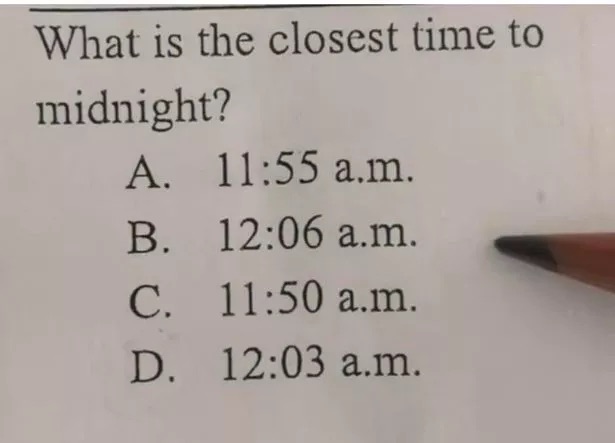Admittedly, some of the math problems assigned to our kids for homework can be perplexing for us, even though they seem to solve them with ease. Many aspects of math aren’t used in our daily lives, so it’s easy to forget how to apply them, leaving us feeling a bit out of practice when faced with what should be straightforward questions.
This seemingly straightforward puzzle has followed the same trend. It went viral on social media after multiple shares, with some users even claiming that trying to solve it was so challenging it gave them a headache.

The question, shared on X (formerly Twitter) by a user with the handle @yawdmontweet, posed a seemingly simple query: “What is the closest time to midnight?” Test-takers were given four multiple-choice answers: “A. 11:55 am, B. 12:06 am, C. 11:50 am, or D. 12:03 am.” While the answer might initially appear straightforward, the comments section of the tweet revealed widespread confusion. People debated whether the question was asking for the time closest to, but not past, midnight, leading to differing opinions and interpretations.
For this reason, many believed the answer was A, reasoning that it’s the latest time listed and thus the closest to the following midnight. One person commented, “It says closest ‘to’ midnight, not ‘from’ midnight. Stop overcomplicating everything. Answer is A.”
Others echoed this sentiment, stating, “It says closest to midnight… not after midnight. A.” Another added, “It would have to be A, time cannot go in reverse so the fact that B and D are after midnight, they couldn’t be the answer.”
However, this perspective was challenged by other commenters who argued that the question simply asked which time was “closest” to midnight, irrespective of whether it was before or after, pointing to D, 12:03 am, as the correct answer. One frustrated user exclaimed, “Y’all are getting me f***ing mad now. If you call an airline and ask for the closest flight to midnight possible and they put you on an 11:55 am flight instead of a few minutes past midnight, you would be frigging furious. Maths is supposed to be practical.”
Another supported this view, questioning, “How y’all saying ‘to’ not ‘after’. If you have to work at midnight and you’re running late, and you tell the boss ‘I’ll get there as close to the time as possible,’ which of these is that?”
Adding to the debate, another commenter noted, “The question speaks to proximity and not chronology, so the answer is D,” while yet another stated, “Clearly a lot of children have been left behind. The answer is D!!! ‘To’ just means closest to the time itself, not insinuating that it’s necessarily before midnight.”
